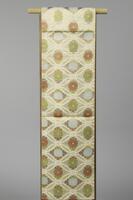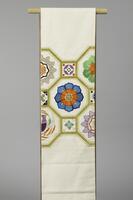28 UMMA Objects
28 UMMA Objects
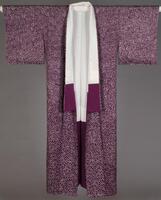
Japanese (Japanese (culture or style))
Kimono
1960 – 1979
Gift of Howard and Patricia Yamaguchi
2005/1.360
![<p>The beginning of the 14th century saw a change in inlaid patterns from using both black and white clay to only using white clay, as demonstrated by this bowl. Concentric white circles extend around the upper and lower parts of the inner and outer surfaces, while the inner wall features a chrysanthemum design in three places. Sand is stuck to the foot and the outer base. The bowl is tinged with vivid yellow. Parts of the rim are slightly damaged, but the glaze is finely fused.<br />
[<em>Korean Collection, University of Michigan Museum of Art </em>(2014) p.107]</p>
<p>The beginning of the 14th century saw a change in inlaid patterns from using both black and white clay to only using white clay, as demonstrated by this bowl. Concentric white circles extend around the upper and lower parts of the inner and outer surfaces, while the inner wall features a chrysanthemum design in three places. Sand is stuck to the foot and the outer base. The bowl is tinged with vivid yellow. Parts of the rim are slightly damaged, but the glaze is finely fused.<br />
[<em>Korean Collection, University of Michigan Museum of Art </em>(2014) p.107]</p>](/media/W1siZiIsIjIwMjIvMDkvMjQvMjN4bWZrM29rYl9kZWZhdWx0LmpwZyJdLFsicCIsInRodW1iIiwiMjQweDIwMCJdXQ?sha=00c2f5b728ac5938)
Korean (Korean (culture or style))
Shallow bowl with inlaid chrysanthemum designs
14th century
Gift of Bruce and Inta Hasenkamp and Museum purchase made possible by Elder and Mrs. Sang-Yong Nam
2004/1.250
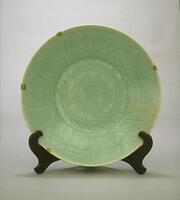
Chinese (Chinese (culture or style))
Plate
16th century
Gift of the William T. and Dora G. Hunter Collection
2002/2.6
![<p>This octagonal dish is inlaid with a chrysanthemum design with white and black slip on each facet. Its outer base is entirely glazed and has three quartzite spur marks. The inner surface is undecorated but covered in crackles, revealing the gray body. The glaze was oxidized during ring, leaving many areas brown.<br />
[<em>Korean Collection, University of Michigan Museum of Art </em>(2014) p.117]<br />
</p>
<p>This octagonal dish is inlaid with a chrysanthemum design with white and black slip on each facet. Its outer base is entirely glazed and has three quartzite spur marks. The inner surface is undecorated but covered in crackles, revealing the gray body. The glaze was oxidized during ring, leaving many areas brown.<br />
[<em>Korean Collection, University of Michigan Museum of Art </em>(2014) p.117]<br />
</p>](/media/W1siZiIsIjIwMjIvMDkvMjQvNHVpbG92a2E1bl9kZWZhdWx0LmpwZyJdLFsicCIsInRodW1iIiwiMjQweDIwMCJdXQ?sha=811709a388c3f99f)
Korean (Korean (culture or style))
Octagonal faceted bowl with inlaid design of paired chrysanthemums on outer side
1250 – 1350
Gift of Bruce and Inta Hasenkamp and Museum purchase made possible by Elder and Mrs. Sang-Yong Nam
2004/1.234
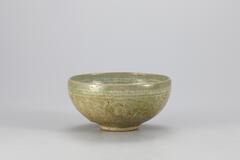
Korean (Korean (culture or style))
Wine cup with inlaid design of cranes flying among clouds
14th century
Gift of Bruce and Inta Hasenkamp and Museum purchase made possible by Elder and Mrs. Sang-Yong Nam
2004/1.247
![<p>This cup is similar in appearance to a round pot, with its mouth curving inwards slightly. The glaze has been oxidized, producing brown tints. The outer rim is black inlaid with a fret-patterned band, below which is also inlaid in black with chrysanthemum spray designs in three places. Coarse sand is stuck on the entire foot and outer base. Glaze has owed down to the interior of the cup during ring and has severely peeled off from the mouth and the outer surface in parts, exposing the body.<br />
[<em>Korean Collection, University of Michigan Museum of Art</em> (2014) p.123]<br />
</p>
<p>This cup is similar in appearance to a round pot, with its mouth curving inwards slightly. The glaze has been oxidized, producing brown tints. The outer rim is black inlaid with a fret-patterned band, below which is also inlaid in black with chrysanthemum spray designs in three places. Coarse sand is stuck on the entire foot and outer base. Glaze has owed down to the interior of the cup during ring and has severely peeled off from the mouth and the outer surface in parts, exposing the body.<br />
[<em>Korean Collection, University of Michigan Museum of Art</em> (2014) p.123]<br />
</p>](/media/W1siZiIsIjIwMjIvMDkvMjQvOG9sZTg1M2QydV9kZWZhdWx0LmpwZyJdLFsicCIsInRodW1iIiwiMjQweDIwMCJdXQ?sha=459b8b86f161841d)
Korean (Korean (culture or style))
Small Cup
1200 – 1399
Gift of Bruce and Inta Hasenkamp and Museum purchase made possible by Elder and Mrs. Sang-Yong Nam
2004/1.251
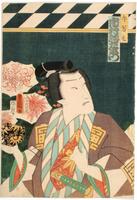
Utagawa Kunisada (Japanese (culture or style))
Kiichi Hōgen and His Book of Strategy: Ichimura Uzaemon XIII as Ushiwakamaru
1861
Gift of Dr. James Hayes
2003/1.485.1
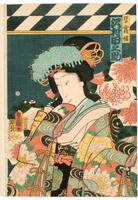
Utagawa Kunisada (Japanese (culture or style))
Kiichi Hōgen and His Book of Strategy: Sawamura Tanosuke III as Princess Minazuru
1861
Gift of Dr. James Hayes
2003/1.485.2
Loading…


